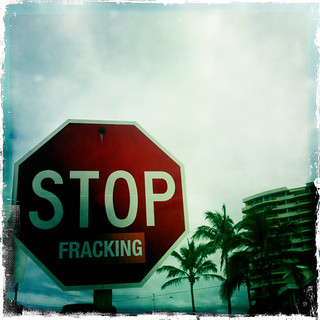This month's discussion group will look at uranium mining and fracking in Australia. For those who can't make the discussion, there are some overviews below. Feel free to add comments if you have questions or opinions to share.
Uranium Mining in Australia
There have been three main bursts of uranium mining exploration in Australia. The first was in the mid-1940s and 1950s, after pressure from the US and UK governments encouraged the federal government to offer tax concessions. The second came in the late 1960s as nuclear power began to take off, and the third has happened since 2002 (driven, in part, by claims that nuclear power will help to provide an energy source with a lower impact on climate change than coal).
Opposition to uranium mining has accompanied these developments, with activists concerned about the environmental impacts, the impacts on Aboriginal communities and lands, and the links between uranium mining and nuclear weapons.
The Wikipedia entries on uranium mining in Australia and the anti-nuclear movement in Australia both provide useful overviews.
This interactive map provides a useful overview of previous, current, and proposed nuclear sites, covering processing facilities and waste storage sites as well as military and mine sites.
The RoxStop website offers some suggestions on how to take action on uranium mining in Australia, including signing petitions and shifting your super away from funds that invest in uranium mining.
The Lizard's Revenge website provides information on the upcoming attempt to highlight the problems with the expansion of Olympic Dam.
For people in Western Australia, the Conservation Council of Western Australia has provided an overview of the problems with the proposed Toro Energy mine at Wiluna.
Fracking in Australia
Fracking is a relatively recent development in Australia: the technology has only become feasible over the last decade or so, and while it has been used quite extensively elsewhere Australia has seen the most rapid expansion of fracking since 2010. Fracking involves using pressurised fluid mixed with sand and a range of chemicals to fracture gas reservoirs so that the gas can be accessed. There are a number of concerns about this technology, including the environmental impacts and the impacts on farmers.
This article in The Economist, Gas Goes Boom, looks at the development of fracking in Australia, as well as some of the concerns about the environment and effects on farmers.
Dennis Cooke's Explainer: coal seam gas, shale gas, and fracking in Australia on The Conversation is also a good starting-point for those wanting to find out more.
For more on opposition to fracking in Australia, you can visit:
Uranium Mining in Australia
There have been three main bursts of uranium mining exploration in Australia. The first was in the mid-1940s and 1950s, after pressure from the US and UK governments encouraged the federal government to offer tax concessions. The second came in the late 1960s as nuclear power began to take off, and the third has happened since 2002 (driven, in part, by claims that nuclear power will help to provide an energy source with a lower impact on climate change than coal).
 |
| Photo courtesy of Alberto OG on Flickr |
Opposition to uranium mining has accompanied these developments, with activists concerned about the environmental impacts, the impacts on Aboriginal communities and lands, and the links between uranium mining and nuclear weapons.
The Wikipedia entries on uranium mining in Australia and the anti-nuclear movement in Australia both provide useful overviews.
This interactive map provides a useful overview of previous, current, and proposed nuclear sites, covering processing facilities and waste storage sites as well as military and mine sites.
The RoxStop website offers some suggestions on how to take action on uranium mining in Australia, including signing petitions and shifting your super away from funds that invest in uranium mining.
The Lizard's Revenge website provides information on the upcoming attempt to highlight the problems with the expansion of Olympic Dam.
For people in Western Australia, the Conservation Council of Western Australia has provided an overview of the problems with the proposed Toro Energy mine at Wiluna.
Fracking in Australia
 |
| Photo from Darth Ambiguous on Flickr |
This article in The Economist, Gas Goes Boom, looks at the development of fracking in Australia, as well as some of the concerns about the environment and effects on farmers.
Dennis Cooke's Explainer: coal seam gas, shale gas, and fracking in Australia on The Conversation is also a good starting-point for those wanting to find out more.
For more on opposition to fracking in Australia, you can visit:
- No Fracking WAy (in Western Australia)
- The Lock the Gate Alliance (Queensland)

Thanks for this!
ReplyDeleteThere's quite a bit of info on fracking in WA at Alison Xamon's site too:
http://www.alisonxamon.org.au/unconventional-gas-and-fracking